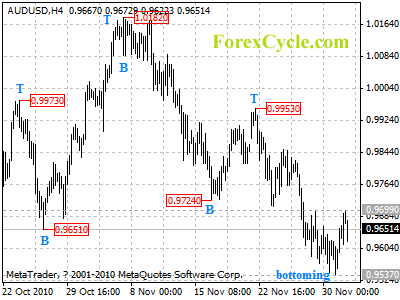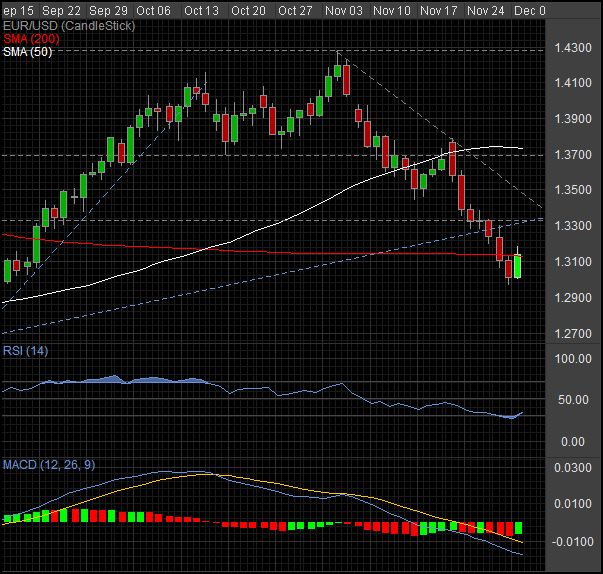By GCI Forex Research
Fundamental Outlook at 0800 GMT (EDT + 0400)
USD
Safe-haven currencies remained supported in Asia Wednesday on escalating concerns over Eurozone sovereign risk, but the dollar failed to make any lasting gains. EURUSD traded 1.2971-1.3039, USDJPY 83.38-83.72.
US data was generally positive. The Conference Board consumer confidence index and the Chicago PMI beat expectations. Weekly store sales showed solid gains, though the S&P/Case Shiller home price index was below consensus. ISM Manufacturing and the Fed’s Beige Book are due and releases should again play a secondary role to broader Eurozone concerns. We remain constructive on the dollar in the current environment.
EUR
The euro remains under pressure as contagion fears persist. ECB President Trichet said “observers are tending to underestimate the determination of governments” and he doesn’t believe Eurozone financial stability could be called into question. Trichet said ECB bond purchases are ongoing and “we will see what we decide” on the program in the future.
S&P placed Portugal on watch negative, with a Reuters headline suggesting that this was to reflect “risks from possible recourse to official funding by [the] government”. Comments from the Portuguese Prime Minister hit the wires immediately after the S&P negative credit watch headlines, and quoted him as saying that reports of pressure on Portugal to ask for a bailout are not true and he remains convinced that decisions by Brussels will make yields retreat.
IMF First Deputy Managing Director Lipsky said that “the notion that the euro is under threat is wildly exaggerated given what’s happening in markets.” But Bofinger, an economic adviser to the German government, said the risks to the euro are enormous and Germany has to decide if it is worth keeping.
Eurozone unemployment was unchanged at 10.1% on an aggregate basis, although the different figures released across Germany, France and the peripherals highlight the diverging paths of the member states. The Eurozone CPI estimate was unchanged as expected at 1.9% y/y.
JPY
BoJ policy board member Suda said there is a strong chance Japan’s economy could contract in Q4, and that the risk of a prolonged period of economic weakness is high. On the policy front, she dismissed the idea of cutting the interest rate the Bank currently pays on reserves, but said the BoJ has the option of boosting the size of its asset purchase fund. Intriguingly, she said the chances of the BoJ buying foreign bonds in future is very low, but not zero. Suda said that, for now at least, the costs of any such approach would outweigh the benefits.
CAD
Q3 GDP in Canada was lower than expected at 1.0% although Q2 was revised slightly higher. The monthly GDP reading for September showed a contraction, the first since August 2009. The Canadian dollar weakened on the release but held in relatively well given the reduced risk-seeking across the board.
AUD
The AUD weakened after Q3 GDP growth missed expectations, only managing to rise +0.2% q/q (cons. 0.4%, prev. 1.1%). Our Australian economics team note that the weaker print raises the risk that the RBA stays on hold for longer. They now acknowledge the risk that rate hikes currently forecast for H1 2011 may not materialise until H2 2011, which would allow the economy more time to strengthen.
TECHNICAL OUTLOOK
AUDUSD clears 0.9542.
EURUSD BEARISH Clearance of 1.2988 exposes 1.2796 ahead of 1.2588. Resistance at 1.3150.
USDJPY BULLISH Recovery held at 84.41; breach of the level would expose 85.40 reaction high. Initial support at 82.79.
GBPUSD BEARISH Violation of 1.5509 exposes 1.5297. Near-term resistance at 1.5773.
USDCHF BULLISH Upside potential held at 1.0054 ahead of 1.0183. Near-term support at 0.9849.
AUDUSD BEARISH Push below 0.9542 opens up the way towards 0.9477 Fibonacci support. Resistance at 0.9712.
USDCAD BULLISH Clears 1.0264, room for 1.0374 next resistance. Near-term support at 1.0171.
EURCHF BEARISH Move below 1.3072 leaves little support till 1.2766 key low. Near-term resistance at 1.3132.
EURGBP BEARISH Break of 0.8402 opens up the way towards 0.8329 and 0.8202 next. Resistance at 0.8449.
EURJPY BEARISH Decline through 109.35 exposes 107.73 and 105.44 key low. Near-term resistance at 110.69 intraday high.
Forex Daily Market Commentary provided by GCI Financial Ltd.
GCI Financial Ltd (”GCI”) is a regulated securities and commodities trading firm, specializing in online Foreign Exchange (”Forex”) brokerage. GCI executes billions of dollars per month in foreign exchange transactions alone. In addition to Forex, GCI is a primary market maker in Contracts for Difference (”CFDs”) on shares, indices and futures, and offers one of the fastest growing online CFD trading services. GCI has over 10,000 clients worldwide, including individual traders, institutions, and money managers. GCI provides an advanced, secure, and comprehensive online trading system. Client funds are insured and held in a separate customer account. In addition, GCI Financial Ltd maintains Net Capital in excess of minimum regulatory requirements.
DISCLAIMER: GCI’s Daily Market Commentary is provided for informational purposes only. The information contained in these reports is gathered from reputable news sources and is not intended to be U.S.ed as investment advice. GCI assumes no responsibility or liability from gains or losses incurred by the information herein contained.



